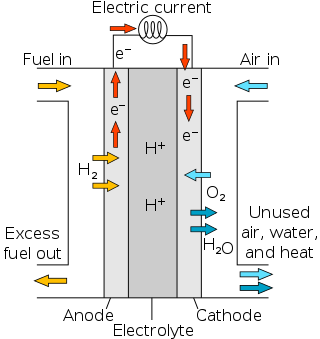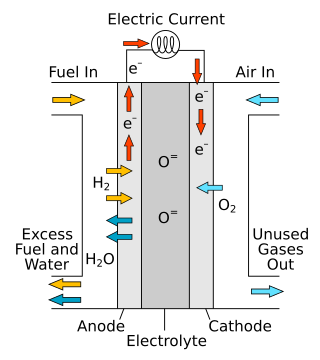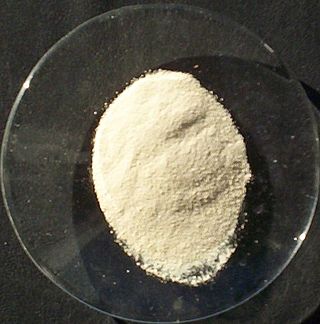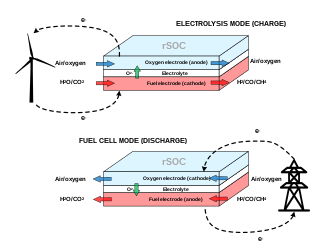Related Research Articles

Gadolinium is a chemical element; it has symbol Gd and atomic number 64. Gadolinium is a silvery-white metal when oxidation is removed. It is a malleable and ductile rare-earth element. Gadolinium reacts with atmospheric oxygen or moisture slowly to form a black coating. Gadolinium below its Curie point of 20 °C (68 °F) is ferromagnetic, with an attraction to a magnetic field higher than that of nickel. Above this temperature it is the most paramagnetic element. It is found in nature only in an oxidized form. When separated, it usually has impurities of the other rare-earths because of their similar chemical properties.

Strontium titanate is an oxide of strontium and titanium with the chemical formula SrTiO3. At room temperature, it is a centrosymmetric paraelectric material with a perovskite structure. At low temperatures it approaches a ferroelectric phase transition with a very large dielectric constant ~104 but remains paraelectric down to the lowest temperatures measured as a result of quantum fluctuations, making it a quantum paraelectric. It was long thought to be a wholly artificial material, until 1982 when its natural counterpart—discovered in Siberia and named tausonite—was recognised by the IMA. Tausonite remains an extremely rare mineral in nature, occurring as very tiny crystals. Its most important application has been in its synthesized form wherein it is occasionally encountered as a diamond simulant, in precision optics, in varistors, and in advanced ceramics.
A regenerative fuel cell or reverse fuel cell (RFC) is a fuel cell run in reverse mode, which consumes electricity and chemical B to produce chemical A. By definition, the process of any fuel cell could be reversed. However, a given device is usually optimized for operating in one mode and may not be built in such a way that it can be operated backwards. Standard fuel cells operated backwards generally do not make very efficient systems unless they are purpose-built to do so as with high-pressure electrolysers, regenerative fuel cells, solid-oxide electrolyser cells and unitized regenerative fuel cells.

Proton-exchange membrane fuel cells (PEMFC), also known as polymer electrolyte membrane (PEM) fuel cells, are a type of fuel cell being developed mainly for transport applications, as well as for stationary fuel-cell applications and portable fuel-cell applications. Their distinguishing features include lower temperature/pressure ranges and a special proton-conducting polymer electrolyte membrane. PEMFCs generate electricity and operate on the opposite principle to PEM electrolysis, which consumes electricity. They are a leading candidate to replace the aging alkaline fuel-cell technology, which was used in the Space Shuttle.

A solid oxide fuel cell is an electrochemical conversion device that produces electricity directly from oxidizing a fuel. Fuel cells are characterized by their electrolyte material; the SOFC has a solid oxide or ceramic electrolyte.

Cerium(IV) oxide, also known as ceric oxide, ceric dioxide, ceria, cerium oxide or cerium dioxide, is an oxide of the rare-earth metal cerium. It is a pale yellow-white powder with the chemical formula CeO2. It is an important commercial product and an intermediate in the purification of the element from the ores. The distinctive property of this material is its reversible conversion to a non-stoichiometric oxide.

Bismuth(III) oxide is perhaps the most industrially important compound of bismuth. It is also a common starting point for bismuth chemistry. It is found naturally as the mineral bismite (monoclinic) and sphaerobismoite, but it is usually obtained as a by-product of the smelting of copper and lead ores. Dibismuth trioxide is commonly used to produce the "Dragon's eggs" effect in fireworks, as a replacement of red lead.
CGO may refer to:

In materials science, fast ion conductors are solid conductors with highly mobile ions. These materials are important in the area of solid state ionics, and are also known as solid electrolytes and superionic conductors. These materials are useful in batteries and various sensors. Fast ion conductors are used primarily in solid oxide fuel cells. As solid electrolytes they allow the movement of ions without the need for a liquid or soft membrane separating the electrodes. The phenomenon relies on the hopping of ions through an otherwise rigid crystal structure.

Lanthanum strontium manganite (LSM or LSMO) is an oxide ceramic material with the general formula La1−xSrxMnO3, where x describes the doping level.
Genoa Joint Laboratories (GJL) is a scientific research activity founded in 2002, combining expertise in electroceramics and electrochemistry of three facilities: National Research Council - Institute for Energetics and Interphases (CNR-IENI), Department of Chemical and Process Engineering with University of Genova (DICHeP), and the Department of Chemistry and Industrial Chemistry with University of Genova (DCCI), all located in Genoa, Italy.

Yttria-stabilized zirconia (YSZ) is a ceramic in which the cubic crystal structure of zirconium dioxide is made stable at room temperature by an addition of yttrium oxide. These oxides are commonly called "zirconia" (ZrO2) and "yttria" (Y2O3), hence the name.

Ultrasonic nozzles are a type of spray nozzle that use high frequency vibrations produced by piezoelectric transducers acting upon the nozzle tip that create capillary waves in a liquid film. Once the amplitude of the capillary waves reaches a critical height, they become too tall to support themselves and tiny droplets fall off the tip of each wave resulting in atomization.

A solid oxide electrolyzer cell (SOEC) is a solid oxide fuel cell that runs in regenerative mode to achieve the electrolysis of water by using a solid oxide, or ceramic, electrolyte to produce hydrogen gas and oxygen. The production of pure hydrogen is compelling because it is a clean fuel that can be stored, making it a potential alternative to batteries, methane, and other energy sources. Electrolysis is currently the most promising method of hydrogen production from water due to high efficiency of conversion and relatively low required energy input when compared to thermochemical and photocatalytic methods.

Solid-state ionics is the study of ionic-electronic mixed conductor and fully ionic conductors and their uses. Some materials that fall into this category include inorganic crystalline and polycrystalline solids, ceramics, glasses, polymers, and composites. Solid-state ionic devices, such as solid oxide fuel cells, can be much more reliable and long-lasting, especially under harsh conditions, than comparable devices with fluid electrolytes.

Cerium(III) acetylacetonate is a compound with formula Ce(C5H7O2)3(H2O)x. It is typically isolated as the trihydrate. Partial dehydration gives the dihydrate, a red-brown solid.

Gadolinium acetylacetonate is a compound with formula Gd(C5H7O2)3(H2O)2. It is a gadolinium(III) complex with three acetylacetonate and two aquo ligands.

Mixed conductors, also known as mixed ion-electron conductors(MIEC), are a single-phase material that has significant conduction ionically and electronically. Due to the mixed conduction, a formally neutral species can transport in a solid and therefore mass storage and redistribution are enabled. Mixed conductors are well known in conjugation with high-temperature superconductivity and are able to capacitate rapid solid-state reactions.

A reversible solid oxide cell (rSOC) is a solid-state electrochemical device that is operated alternatively as a solid oxide fuel cell (SOFC) and a solid oxide electrolysis cell (SOEC). Similarly to SOFCs, rSOCs are made of a dense electrolyte sandwiched between two porous electrodes. Their operating temperature ranges from 600°C to 900°C, hence they benefit from enhanced kinetics of the reactions and increased efficiency with respect to low-temperature electrochemical technologies.

Samarium(III) nitrate is an odorless, white-colored chemical compound with the formula Sm(NO3)3. It forms the hexahydrate, which decomposes at 50°C to the anhydrous form. When further heated to 420°C, it is converted to the oxynitrate, and at 680°C it decomposes to form samarium(III) oxide.
References
- 1 2 3 Badwal, S. P. S.; Fini, D.; Ciacchi, F. T.; Munnings, C.; Kimpton, J. A.; Drennan, J. (2013). "Structural and microstructural stability of ceria – gadolinia electrolyte exposed to reducing environments of high temperature fuel cells". Journal of Materials Chemistry A. 1 (36): 10768. doi:10.1039/c3ta11752a.
- ↑ "Gadolinia doped Ceria GDC | AMERICAN ELEMENTS ® Supplier & Info". Americanelements.com. 2010-08-24. Retrieved 2013-08-16.
- ↑ "Publica". Publica.fraunhofer.de. Retrieved 2013-08-16.
- ↑ Garche, Jurgen. et al., ed. Encyclopedia of Electrochemical Power Sources. Oxford: Newnes, 2009.
- ↑ "Comparative Study for Average Crystallite Size of gadolinium doped-ceria synthesized by different methods" (PDF). Sbpmat.org.br. Retrieved 2013-08-16.
- ↑ "Fabrication of 10%Gd-doped ceria (GDC)/NiO-GDC half cell for low or intermediate temperature solid oxide fuel cells using spray pyrolysis" . Retrieved 2013-08-16.
- ↑ Luo, Dan; Luo, Zhongyang; Yu, Chunjiang; Cen, Kefa (2007). "Study on Agglomeration and Densification Behaviors of Gadolinium-Doped Ceria Ceramics". Journal of Rare Earths. 25 (2): 163–167. doi:10.1016/S1002-0721(07)60066-0.
- 1 2 Rossinyol, Emma, et al. "Gadolinium Doped Ceria Nanocrystals Synthesized From Mesoporous Silica." J Nanopart Res (2008) 10:369–375 doi : 10.1007/s11051-007-9257-z
- ↑ Halmenschlager, C. M.; Neagu, R.; Rose, L.; Malfatti, C. F.; Bergmann, C. P. (2013-02-01). "Influence of the process parameters on the spray pyrolysis technique, on the synthesis of gadolinium doped-ceria thin film". Materials Research Bulletin. 48 (2): 207–213. doi:10.1016/j.materresbull.2012.09.073. ISSN 0025-5408.
- ↑ Bocchetta, Patrizia; Santamaria, Monica; Di Quarto, Francesco (2012). "Electrodeposition of Supported Gadolinium-Doped Ceria Solid Solution Nanowires". Journal of the Electrochemical Society. Jes.ecsdl.org. 159 (5): E108–E114. doi:10.1149/2.005206jes.